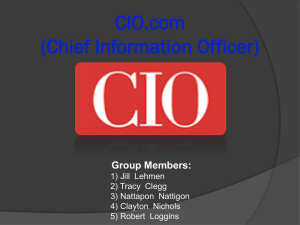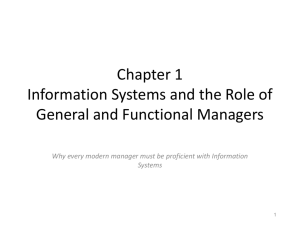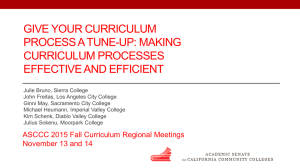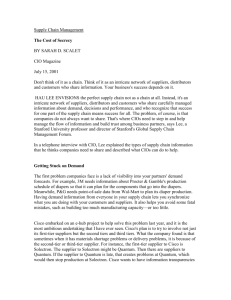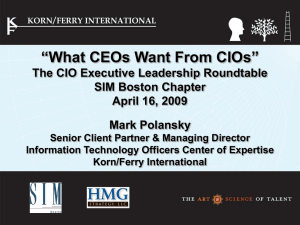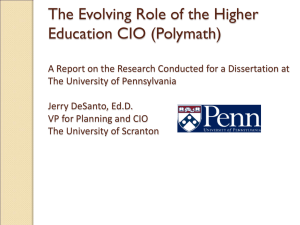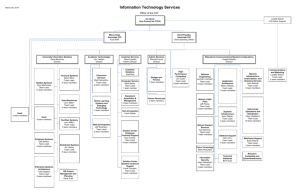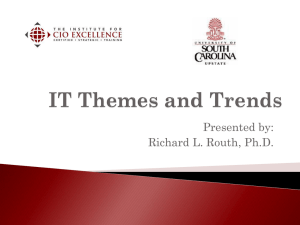CHANGING ROLE OF THE CISR WP #113
advertisement
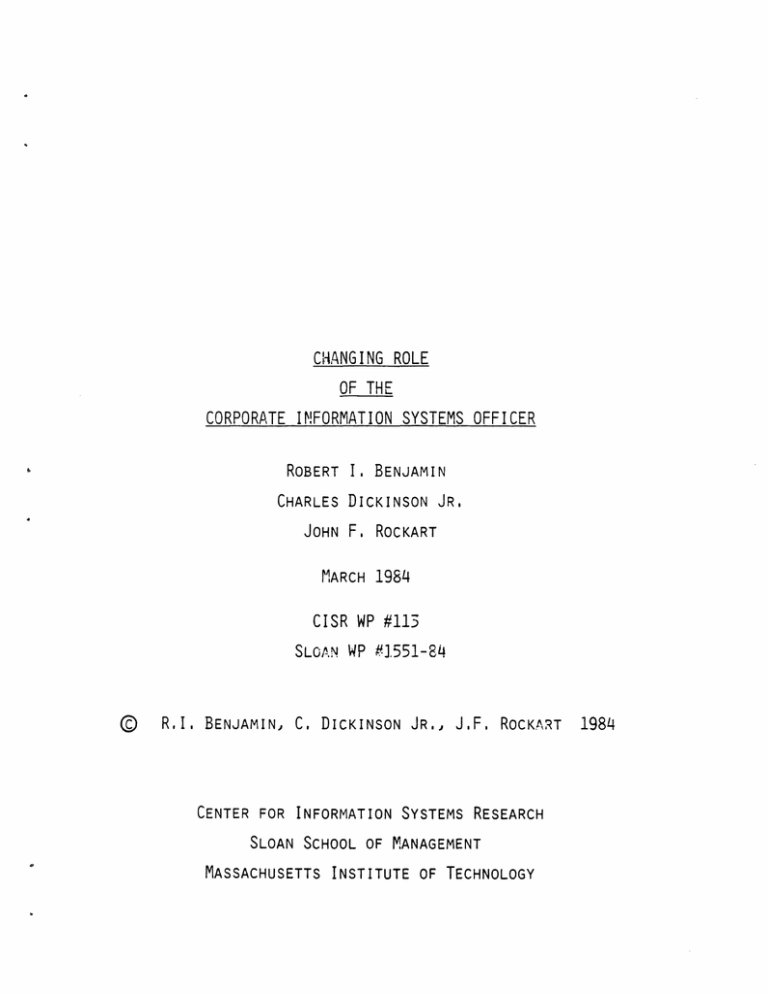
CHANGING ROLE OF THE CORPORATE INFORMATION SYSTEMS OFFICER ROBERT I. BENJAMIN CHARLES DICKINSON JR. JOHN F. ROCKART MARCH 1984 CISR WP #113 SLOAN WP C 1551-84 R.I, BENJAMIN, C. DICKINSON JR., J.F. ROCKART CENTER FOR INFORMATION SYSTEMS RESEARCH SLOAN SCHOOL OF MANAGEMENT MASSACHUSETTS INSTITUTE OF TECHNOLOGY 1984 CHANGING ROLE OF THE CORPORATE INFORMATION OFFICER I/S managers hardly need to be told that their world is changing. Change is everywhere -- a harsher, more competitive business environment; rapidly evolving information increasingly knowledgeable, constituencies. demanding, The purpose of this paper that Information and diverse and user The problem for I/S managers is not one of acknowledging change; it is one of effort technology; describes Officers adapting to it successfully. is to report on a recent research the adaptation (CIOs). made by Corporate The results of this research suggest that our sample of CIOs, among the most successful in the industry, are rapidly developing a new role for themselves -- one that is radically different from the traditional role of the I/S Manager. In describing this new role of the CIO, we shall draw upon two types of material: First, a set of predictions about the changing nature of the I/S function and the role of the CIO. Second, findings from the CIO research, designed to test the validity of the predictions. 1 CHANGING ROLE OF THE CORPORATE INFORMATION I. THE CHANGING WORLD OF THE CIO: OFFICER PREDICTIONS While CIOs have coped, some more successfully than others, with the changes in their world during the last several years, researchers and consultants have attempted to understand and describe these changes. Some strong perspectives have emerged on the direction It is that useful, leading-edge organizations have been taking. therefore, to summarize several of these perspectives as a backdrop to our research findings. Richard Nolan (1), for example, has suggested that I/S is currently in a period of "technological discontinuity" as it makes the transition from traditional "DP technology" (characterized by mainframe computers and common software under the control of a centralized data new user-dominated technology. processing organization) to a Just as the traditional DP technology has its own "learning curve" (which provided the basis for Nolan's original description of the stages of DP growth (2)), so does the newer, user-dominated technology. the current I/S environment The complexity of is caused by the discontinuity and change associated with the transition from one learning curve to another. Nolan and others who have participated in his research, identify several implications for I/S management: - The "computer" infrastructure of organizations will shift dramatically to the new user-dominated technologies. - Senior management is looking to Corporate I/S for leadership in making the transition across learning curves. - Companies are being forced to shift from "narrow DP planning" to "enterprise 2 wide Computer Architecture CHANGING ROLE OF THE CORPORATE INFORMATION OFFICER planning". As Nolan points out, a major issue for companies as they pass through this "window" of technological discontinuity is one of leadership--effective management of the transition from traditional technology to the user-driven technologies. Benjamin(3) draws upon Nolan's framework, but is more specific about the types of changes or discontinuities that I/S is experiencing as it moves from one technology to the other. He describes five discontinuities: - There is a powerful trend in the direction of greater distribution and complexity of processing environments all major organizations today. in This trend will increase in velocity with the introduction of newer, lower cost, and more powerful technologies. - Unprecedented user demand has been generated by the explosive growth in workstations, available software packages, and easy-to-use languages. This demand is now driving I/S resource management when previously I/S managed the resource by controlling its supply. - New ways of developing systems--where the user can develop and operate many applications himself--are radically changing the power balance between I/S and the user organizations. - In contrast to the communications task of the 70's-- the connection of workstations to specific applications on mainframes-- the communications task of the 80's is much 3 III CHANGING ROLE OF THE CORPORATE INFORMATION more complex. applications OFFICER It consists of interconnecting a range of to a single workstation, interconnecting the hierarchy of processing environments, and making data bases accessible wherever needed in the organization. - In the long run of most fundamental significance, is the realization that I/S has become a factor in business strategy. Today's information technologies, coupled with advances in data communications, have made information systems a competitive weapon to be considered advantage. Accordingly, in I/S the fight management for must develop an outward business-strategy perspective in addition to its traditional operational focus. Other authors, Rockart, Bullen and Ball(4 ) (subsequently referred to as RBB) emphasize an evolving management -- and in particular for staff orientation for I/S the CIO. Drawing upon the combined thinking of a group of successful CIOs researchers in the field, and established they theorize about the evolving CIO role. The new CIO role, as RBB envision it, is developing to the powerful forces discontinuities discussed generated above. by the in response trends and The result is not only a different role for the CIO, but a new set of requisite managerial attributes for the individuals in that role. More specifically, RBB make three "predictions" regarding the emerging role for the CIO: CHANGING ROLE OF THE CORPORATE INFORMATION - OFFICER He will manage the decentralization of most of his former line responsibilities to divisions and departments. - His management style will be staff rather than line oriented. - He will assume clear responsibility for information resource policy and strategy. Each of these predictions is described in more detail below: A. Decentralization of line responsibilities to divisions and departments. The new business environment will make it impossible for the CIO to maintain computer-based direct line technology management throughout control the over company. Accordingly, "line management of local hardware and much of the software development will be thrust into divisions and departments"( 5 ). Nonetheless, the CIO will necessarily retain direct, responsibility the for several critical areas associated information "infrastructure" of the firm. line with These areas will include the communications network, corporate data management, common software development (including a changing array of start-up projects), and the corporate computing facility. B. Staff orientation The new emphasis on staff-oriented responsibilities will result in the need for organizations to have a "focal point" 5 II1 CHANGING ROLE OF THE CORPORATE INFORMATION for planning and facilitating the "information era" (or, OFFICER the organization's move in Nolan's terminology, into into the Advanced Stages of user-dominated technologies). The CIO will increasingly focus on strategies and planning. He/she will be oriented towards facilitating, promoting change -- but will not control guiding, and it. Techniques which will be utilized by the CIO to guide, facilitate and promote and will include: communication education processes, standards (e.g., for data, communication, privacy and security), committees, and other policies, indirect and controls (e.g., guidelines, and steering individual persuasion). Rather than being the "owner" of a centralized I/S technology, "integrator" of the CIO will an become the increasingly "gate-keeper" and diverse spectrum of technology resources which will be decentralized throughout the firm. C. Corporate responsibility for information resource policy and strategy Increasingly, the CIO will be a member of the top management team. He will have broad responsibility for developing policy and strategy for the information resources of the firm, just as the CFO (Chief Financial Officer) has similar responsibility for the financial resources of the firm. This clearly suggests that the CIO will not "custodian" of the data. Rather, he or she simply be the will be the corporate officer who truly understands the interconnection of the information flow to the business. The CIO will have "the responsibility of assuring that new opportunities 6 CHANGING ROLE OF THE CORPORATE INFORMATION OFFICER presented by the technology are seized and that capital expenditures for information resources are ranked according to business needs." ( 6) These predictions describe a radically different role for senior I/S management, and in particular for the CIO, than that performed by the traditional I/S manager. If these predictions are true, RBB suggest that the emerging role for the CIO attributes will require a set which -- though useful of to managerial the skills I/S executive past -- will be absolutely critical in the future. and in the It will not be enough that the CIO have a considerable understanding of the technology. In addition, the CIO must be a general business oriented manager with considerable political, organizational, and communication skills. 7 CHANGING ROLE OF THE CORPORATE INFORMATION OFFICER II. RESEARCH ON THE CIO ROLE RESEARCH MODEL The CIO model developed by Rockart, Bullen and Ball, was developed to identify a range of issues associated with the transitional management of the I/S function in the 1980's. In particular, the predictions about the emerging CIO role and the associated managerial attributes for this role were intended to assist practicing CIO s in adapting successfully to a radically changed environment. Although these predictions may be helpful, their practical value is limited until tested and validated by the actual experiences of successful CIOs in a variety of corporate environments. Our research on the emerging role of the CIO was thus undertaken to determine whether these predictions are, in fact, borne out by the actual experiences of successful CIOs in large corporate environments. Our research model was exploratory and designed to provide some validation for the conclusions of the RBB CIO paper. was small but of very high quality. Our sample A questionnaire was sent to approximately 25 CIOs in a variety of large U.S. and Canadian corporations, of whom 20 (in a few instances their chief aides) responded. connection Because most of the CIOs as sponsors of the have had a long term Center for Information Systems Research (CISR), at the Sloan School, MIT, we were able to place high confidence in the care they took in responding to 8 the OFFICER CHANGING ROLE OF THE CORPORATE INFORMATION survey. As a further step in eliminating ambiguities, the survey respondees at a CISR results were reviewed with most of the workshop in May of 1983. The research The focused on five areas of interest: relationships o Reporting o Corporate I/S budget o Critical responsibilities o Importance of selected I/S initiatives o Organization of I/S functions and activities are respondees representative of large corporations variety of business sectors. companies are the spread these organizations summarized in Exhibit are in manufacturing. Annual as shown in function in these companies for the I/S considerable; the responses, summarized in Exhibit with sales sizeable, Expenditures a 1, the across several different industries, falling preponderance As in Exhibit for 2. are 3, indicate that 60% of the companies expend at least $100 million annually. RESEARCH FINDINGS The three hypotheses by Rockart, Bullen & Ball cited earlier in this paper were made about the changing role of the CIO. Our research was undertaken to test these predictions, to determine whether or not they are validated by the day-to-day experiences Accordingly, we will discuss the findings of this research in the context of each prediction. Our results are not to be treated as "gospel". The research was of practicing, successful CIOs. exploratory in nature, oriented toward a first-cut understanding of an important area of knowledge for 9 the information systems III CHANGING ROLE OF THE CORPORATE INFORMATION OFFICER community and its management, and not toward conclusive results. Our sample is far Yet we believe the results are meaningful statistical work. important trends, of some indicative interesting, and it is not large enough for from random, provide and interesting future direction for research. A. Decentralization of Line Responsibility line control management over the proliferating computer-based that it was predicted As a result, technology in the company. direct for the CIO to maintain It is now virtually impossible line management of local hardware and much of the software development will be thrust into divisions and departments. At the same time, however, it was also predicted that the CIO and corporate I/S would retain certain residual line responsibilities that are primarily associated with developing and maintaining the infrastructure" of the corporation. "information evidence to We found support this trend toward decentralization of line for I/S in responsibility line two I/S areas activities research: the our of to subsidiary distribution of organizations, as well as to user management, I/S and the changing size and composition of the corporate I/S budget. (1) Distribution of line activities to subsidiary I/S units and user management Results from decentralization definitely CIO the taking of line place. questionnaire activities CIOs were from indicate that corporate I/S asked location of responsibility -- corporate I/S, 10 to indicate a is the subsidiary I/S CHANGING ROLE OF THE CORPORATE INFORMATION groups, or user management - OFFICER for an extensive list of staff and line activities, grouped into 4 general I/S management functions (planning, managing, I/S internal services, and I/S user services). Exhibit 4 presents a percentage distribution of these activities, highlights all activities where the CIOs were at least 60% agreed on whether the activities are currently located in corporate I/S or functions, line or and distributed to subordinate I/S or user indicates staff. whether the corporate The data shows clearly that activities are major elements of line responsibility have been distributed to subsidiary I/S groups and user management for the development and operation of application systems. Consistent with the identified as management of hardware having prediction, primary generally agreed by the responsible for and I/S responsibility software. CIOs that operation subsidiary for units the Specifically subsidiary of mainframe I/S and are line it is units are minicomputer hardware, selection and maintenance of applications software, and implementation of the system life cycle, as well as implementation of end-user support. In addition they are seen as having the budgeting responsibility (multi-year and for such annual) line and planning functions architecture design as for applications (as contrasted with architecture design for hardware and data base, where the CIOs are split about even on the issue of accountability). In spite of this significant pattern of decentralization, 11 some CHANGING ROLE OF THE CORPORATE INFORMATION OFFICER key line activities are not distributed to subsidiary I/S units and user management. Most of these activities, as predicted, are either associated with developing and maintaining the information utilities that constitute the I/S infrastructure for the firm; a major role in voice and development of corporate data telecommunications; wide applications (we did not include corporate applications in this critical in Appendix responsibilities or the question, but responses 1 indicated to clearly CIO that this was thought to be a corporate I/S responsibility), such as payroll/personnel or accounting systems. In addition, however, they identified line tasks in support of the corporate staff such as executive support systems. There were a number of activities that the data did not identify clearly as corporate or distributed. Exhibit 4, (those activities lines generally technologies: systems, on are with These no also shaded associated are shown boxes). with new in These evolving telecommunications, personal computers and office and activities where the transition to decentralized operations is still evolving, e.g., applications planning. The distribution of responsibilities is a general trend that has been focused on movement between corporate Some movement of responsibilities between and subsidiary I/S. is taking place subordinate I/S and user management. as well This is shown in Exhibit 5 where those activities that at least 30% of the CIOs perceive user management These emphasize office and to a heavy user personal be responsible management computers 12 and for role external are displayed. in applications, data bases and CHANGING ROLE OF THE CORPORATE INFORMATION OFFICER timesharing. Questionnaire results regarding the distribution of responsibilities generally support the prediction that line responsibility is being decentralized from corporate I/S to subsidiary I/S groups and to user management. Further these results also suggest that the with the information CIO and responsibilities which do remain corporate infrastructure of I/S the form of information utilities, are firm, e.g., implementation of corporate systems. associated with whether it be telecommunications, the in the or the Although these results come from a sample of very large companies subsequent conversations with many other companies of varying sizes indicate that the distribution of I/S responsibility is a pervasive trend today. (2) I/S Budget In addition to the questionnaire focus on allocation of line responsibilities, CIOs were asked to indicate the percentage share of the entire I/S budget that is under their direct control -- both at present and estimated for three years in the future. In addition, they were asked to budget which is dedicated centers, corporate indicate the percentage of their to "service utilities" like data applications, or data telecommunications. systems programming, and voice The premise in asking for this budget information was that size of budget -- and the trend over the next three years--would corroborate, or weaken the CIOs' own stated perceptions of their line/staff relationships. The results of these budget-related 13 questions, graphically II CHANGING ROLE OF THE CORPORATE INFORMATION OFFICER represented in Exhibit 6, suggest that corporate I/S is playing a less dominant role than it has in the past--and that this trend will continue, in terms of overall expenditures, in the future. The average corporate-controlled I/S budget in the 20 firms is only 48% of the entire I/S expenditures in the firm; in the next three years, additionally, it is expected to drop Corporate I/S does not, therefore, even today, majority of I/S expenditures for the firm. to 44%. control the These figures are consistent with the specific line/staff trends discussed in(A1) above. B. Increasing Staff Orientation CIOs are predicted to concentrate increasingly on staff-oriented activities. This new orientation to staff responsibility is dictated by the organization's need to have a focal point for planning and "information CIO will facilitating the era." As play an organization's move the "gatekeeper" increasingly for prominent into the new technology, the role in long-range planning, corporate information strategy, communication and education ofthe potential of I/S technology, as well as the development of standards that will guide others throughout the organization in the use of that technology. (1) Critical Responsibilities of the CIO In order to test this prediction of increased staff orientation, CIOs were asked responsibilities. by each CIO. to describe their few most critical An average of 3 responsibilities was provided In addition, they were asked to indicate how they felt these responsibilities would be different three years from 14 CHANGING ROLE OF THE CORPORATE INFORMATION now. OFFICER Our concern in both of these questions was to determine whether these critical responsibilities were primarily staff or line oriented. The CIO responses, summarized in Exhibit 7, clearly indicate that staff responsibilities are predominant in both instances. Of the 62 responses for current critical responsibilities, 41 (or 66%) categories that are staff-oriented; only 21 (or 34%) can be classified as line responsibilities. Further, to the fall into extent that the CIOs anticipate change in the next three years, most CIOs responded in a manner that was even more heavily weighted of in favor responses, or 87%). staff-oriented (13 of 15 complete listing of categories (See Appendix I for a the CIO responses to these questions.) The current line responsibilities that are cited by the CIOs may be organized into three categories. maintaining information utilities, The first, creating and reflects the residual activities that were identified earlier. by CIOs included, computing center," for example, line Responsibilities cited "manage the corporate-wide "world-wide networks and data," and the like. The other two categories of line responsibility are associated with the direct provision of information services, either at the corporate level exclusively (e.g., systems," "provide corporate," etc.), end-user "operations of corporate computing environment for or for the organization as a whole (e.g., "develop/maintain administrative systems on a worldwide basis," " total responsibility for data processing operations and systems development," etc.) 15 III CHANGING ROLE OF THE CORPORATE INFORMATION planning responsibilities Within the current staff activities, are particularly prominent: responsibilities "information are architecture," 40% of the staff-oriented over associated OFFICER planning (e.g., with technology new " evaluate technology and etc.), determine how it will be effective for our organization",, or " I/S Strategic Planning" ( e.g., linkage to the strategic plan of the goals and "provide direct support corporation), Although the preponderance strategic planning," etc.). of responses in the planning strategic to corporate category reflect an emphasis on supporting business strategy, only two responses emphasized a responsibility to influence the strategy of the firm (e.g., product "influence computer as tool strategy," and, "increase use to increase productivity/profitability of of the corporation)". In addition to the planning responsibilities, such emphasized and consultation staff traditional support operating company CEOs," (e.g., CIO responses also current "provide functions consulting arm as to "establish end user computing and information management," " advise and guide effective utilization of computer and telecommunications technologies," etc). These comprise over a third of the staff-oriented responsibilities identified by the CIOs. category of In addition, the CIOs felt that consultation and support was going to the be significantly more important in the future. The remaining current critical responsibilities identified by the CIOs fall into the management (e.g., staff-oriented categories of human resource "attract, retain, and develop talent," "develop competent people for key jobs in affiliates") and literacy or 16 CHANGING ROLE OF THE CORPORATE INFORMATION OFFICER education on I/S technology (e.g., "see to it that company is in computer technology," "educate key executives on trained possibilities," The etc). human resource category of responsibilities represents a rather traditional staff function. However, the responsibilities associated with fostering a growing literacy and emerging understanding of I/S technology represents an need in communicate the these organizations rapidly changing to potential and understand for operational efficiency and business effectiveness. The CIOs view of his critical responsibilities three years from now is little changed from today (see Appendix IA). He sees his consulting activities and his planning activities more focussed in the future, identifying nine additional consulting activities and four additional planning activities. The staff oriented picture of the CIO's out of the role that is developed list of his critical responsibilities is consistent with the data that describes the distribution of corporate I/S activities to subordinate I/S and user management. Inspection of Exhibit 4 shows that the residual activities left under Corporate line up well with the staff activities described above. What emerges from this aggregated listing of critical responsibilities, both at present and as anticipated for the future, is a rather sharply defined picture of the CIO as a highlevel range manager who planning is primarily concerned (both technical and with issues of long- business-oriented) consultation, and support to a wide-ranging set of constituencies throughout the organization. In addition he 17 is responsible for CHANGING ROLE OF THE CORPORATE INFORMATION OFFICER educating others to the tremendous potential of information This technology for the complex business needs of the firm. picture clearly and orientation, stresses increasingly an significant supports the original prediction, staff at least in the eyes of those polled, that the CIO will become the focal point for planning and facilitating the organization's move into the information era. C. Corporate Responsibility for Information Resource Policy and Strategy RBB also predict that the CIO will increasingly be found among the top-management team, with broad responsibility for developing the information resources of the policy and strategy regarding firm. this research results that are two areas of There suggestion increased of corporate relate to responsibility for information resource policy and strategy. (1) Reporting Relationships In order to gauge CIO standing in the corporate hierarchy, CIOs were asked to indicate their reporting relationship to other top managers, particularly the CEO. The results of this question are summarized in Exhibit 8. These results First, suggest two significant findings: the CIO is clearly becoming an integral part of the top-management team. Sixteen of the 20 CIOs surveyed are positioned within two levels of the CEO -- and four of them (20%) report directly to the CEO - leaving a relatively small minority that are placed three or more levels down in 18 CHANGING ROLE OF THE CORPORATE INFORMATION the organization. OFFICER This finding, more than any other single result from our research process, may signal the "coming of age" of I/S management; no longer is the chief manager the organization chart. the I/S function buried midrange on The of outside CIO reporting relationship is today generally what had been the traditional reporting pattern for I/S executives--through Finance. report outside Engineering, Finance of Chief Sixteen out of 20 of the CIO's of (e.g., Staff). These Operations, organizational reporting paths are very consistent with the culture of the organization. To cite one illustration, chemical corporation with a strong tradition reports to the the CIO of a major research and engineering Senior VP of Research and the importance of selected I/S areas requiring Engineering. (2) Importance of Selected I/S Initiatives CIO's were asked initiatives attention) to rate (specific his concentrated from a scale of 1.."little importance to me as CIO," to 5.."critical to my success as CIO," both now and 3 years in the future. The mean ratings for each of these initiatives and the standard deviation is shown graphically in Exhibit 9, and in tabular form in Appendix II. The three initiatives rated most important by the CIOs were end user services, telecommunications and corporate strategy. CIOs have some confusion about the importance of end user services in the short term (note the large standard deviation), uncertainty about its importance in the long term. 19 _~~~ ~ ~ ~-------_11.~ _ _ _ _1_1_1_1_1~~~~~~-1_--1111 ~~_____1__ --- but little CIOs also III CHANGING ROLE OF THE CORPORATE INFORMATION OFFICER place considerable importance on initiatives in the areas of office systems, and personal computers, which are special forms of end user services. The CIOs see application selection as growing less important to them over time, and given the fact that only 11 out of the 20 companies surveyed (manufacturing and petrochemicals) are in industries where CAD/CAM is significant , they give it considerable importance as an initiative. Directional change in initiatives is consistent with the predictions in section 1. Application selection will be of lower concern as the CIO telecommunications and distributes his responsibility, corporate strategy will be of increasing concern as the CIO consolidates his staff role. much clearer about the importance of section on critical (The CIOs are participating in corporate strategy in this section on initiatives, discussed and than in the previously responsibilities.) It is interesting to note that the three-year-out view of end-user services, telecommunications and corporate strategy initiatives have little dispersion about them, indicating that the CIOs have a consistent sense of where they are heading. 20 CHANGING ROLE OF THE CORPORATE INFORMATION OFFICER CONCLUSIONS, AND III. THE CHANGING ROLE OF THE CIO: FUTURE RESEARCH This research survey conducted with 20 CIOs from major companies provides strong evidence a changed role for the that Chief Information Officer is winning acceptance in major corporations. the specific predictions made by Rockart, Bullen This confirms and Ball, and the more general predictions of Nolan and Benjamin. Of most importance to the I/S executive and to senior management is that the pace of this change is faster than was anticipated. It was predicted to be transitional through the end of the in fact describes the reality for many decade, but companies today. A. The Specifically: distribution subsidiary I/S and of corporate user management is I/S from a functional point of view. their line activities activities proceeding Our research demonstrates this from both corporate leading to rapidly. a budgetary and CIOs are concentrating where interconnection is required -- wide applications, the corporate data network, and managing corporate data. B. The CIO as evidenced by his responses accomplishes his primary goals through staff activities. These goals are moving the organization into the "information era" that has been enabled by the highly cost effective information technologies available. C. The CIOs are proactive executives who in general report 21 ii 111_ __1 _1_1 sn 11 III CHANGING ROLE OF THE CORPORATE INFORMATION OFFICER to the CEO or one level below him and are aligned through their reporting operational relationships to the elements of the business. strategic and Their strongest personal initiatives are in areas of strategic importance: end telecommunications, user computing, planning, (linking I/S to the business, and strategic and gaining competitive advantage through use of information technology) As will all exploratory research, the examination of the data and conclusions raises a number of interesting research questions. The most significant to the authors are: - To what extent is the pattern of distribution of the I/S function described in this paper related to the size of the companies in the sample (which were very large), to the type of industry, and to organizational cultures? - To what extent will the distribution of responsibility from subordinate I/S to user management follow the pattern of distribution of responsibility from corporate to subordinate I/S? In concluding make. this research report we have one final comment to The trends appear strong, not take them into account and I/S organizations that do may encounter significant difficulty in coping with the transitional changes of the '80's. the However implementation of change must proceed in ways that are correct for each organization and its culture. 22 CHANGING ROLE OF THE CORPORATE INFORMATION OFFICER REFERENCES (1) Nolan Richard L; Issue; Managing the Advanced Stages: Key Research to be published in 1984 as part of 75th Anniversary Colloquium papers; Harvard Business School; July 1983 (2) Nolan Richard L, Gibson Cyrus F; Managing The Four Stages of EDP Growth; Harvard Business Review; January-February, 1974 (3) Benjamin, Robert I, Managing Through a Decade of Discontinuity; Information Systems News; August 22 1983, p.20 (4) Rockart John F, Bullen Christine V, Ball Leslie; Future Role of the Information Systems Executive; MIS Quarterly; Special Issue, December 1982. (5) Op. Cit. p.4 (6) Op. Cit. p.5. 23 III EXHIBIT 1 INDUSTRY BASIC COMPANY INFO: CATEGORY NUMBER Manufacturing 9 45 Banking 3 15 Insurance 2 10 Petrochemical 2 10 Government 1 5 Other 3 15 TOTAL 20 100 EXHIBIT 2 BASIC COMPANY INFO: REVENUES NUMBER CATEGORY 9 45 10 50 1 5 $.5 to $5 Billion More Than $5 Billion N/A (Government) 100 TOTAL EXHIBIT 3 BASIC COMPANY INFO: CATEGORY I/S BUDGET NUMBER $10-50 Million 6 30 $50-100 Million 2 10 12 60 20 100 More Than $100 Million TOTAL EXHIBIT 4 DISTRIBUTION OF I/S ACTIVITES (Shown in %'s) CORPORATE VS ACTIVITY PLANNING FOR THE VSFUNCTION · t/SStrategic Planning · * S Annual udgets or Project Plans 33 17 Architture Planning a. HrdWare 45 55 & 50 50 atabase 27 Applications Application Portfolio a. Plan 12 h Prioritize 11 MANAGING THE VSFUNCTION * Mainframes/Mni a. Selection 45 * * * NO ONE RESPONSIBLE 33 Tecnology Scanin/Anticipation c USER MANAGEMENT 28 VS Multi-yer Sudrgets or PrectPlans *· SUBSIDIARY V/S 55 11 b Approval 28 c. Standards 17 d Operations 28 Personal Computers a. Selection 33 b Approval 44 22 34 c. Standards 56 22 11 d. Operations 4 TelecommunicatlonsVoice a. Selection 50 OMMMM///////////// 28 22 11 4 b Approval 11 24 c Standards 17 11 d. Operations 39 22 33 6 55 45 6 6 Telecommunlcatons/Data a. Selection b Approval 12 c Standards 17 d Operations 55 [ = 2 60% Agreement Italics = Line Bold = Staff 33 11 III EXHIBIT 4 DISTRIBUTION OF I/S ACTIVITES (Shown in %'s) ACTIVITY CORPORATE SUBSIDIARY USER NO ONE /S uS MANAGEMENT RESPONSIBLE MANAGING THE I/S FUNCTION (Contd) * * Office Systems a. Selection 17 36 55 17 29 6 29 17 6 b Approval c Standards 55 d. Operations 6 Systems Life Cycle a. Standards b. * 47 61 6 33 6 21 Implementation Applications Software a. Selection 28 39 b. Approval c. Standards 55 d Maintenance 31 45 ///// 45 ////////////////// _ * National/Multinational Vendor Contracts 12 12 * Security/Privacy Standards 12 12 VSINTERNAL SERVICES 29 * Consulting Service/Technical Expertise * VSPersonnel Management 53 41 * Education/Training of VSPersonnel 47 53 * Information Exchange 6 6 6 17 17 27 12 IS USER SERVICES * * VSEducation a. Senior Management b Line Users 33 End User Support 28 Executive Support * Office Systems 41 * External DataBases 12 * Timesharing a. Internal b. * 47 12 31 6 6 External Implementation of Common Systems E = Italics = Bold a 50 60% Agreement Line Staff 22 1 11 EXHIBIT 5 USER MANAGEMENT RESPONSIBILITIES GREATER THAN 30% PERCEPTION BY CIO'S (For Detail See Appendix 1) APPLICATION PORTFOLIO Plan Prioritize 33% 78% PERSONAL COMPUTERS Selection Approval Operations 50% 34% 84% TELECOMMUNICATIONS VOICE Operation 33% OFFICE SYSTEMS Selection Operations 36% 76% APPLICATIONS SOFTWARE Approval 33% EXTERNAL DATA BASES 53% EXTERNAL TIME SHARING 64% III 4I -o x uJ VI z 4- U 0 _) X u - m n- I- D 0 ZD ZD L, - cr. n -.. ut EXHIBIT 7 CRITICAL LINE AND STAFF RESPONSIBILITIES OF CIOs CURRENT AND FUTURE (See Appendix I For Detail) LINE RESPONSIBILITIES CURRENT FREQUENCY CURRENT FUTURE FREQUENCY CHANGE Technology planning 6 +1 6 2. I/S strategic planning 12 +3 8 3. Literacy/education on information technology 6 4. Human resource management 3 5. Consultation/support 7 +9 6. Standards/control 6 __ Create/maintain information utilities 7 2. I/S services, organization-wide 3. I/S services, corporate TOTAL, future change (projected) STAFF RESPONSIBILITIES 1. 1. TOTAL, current responsibilities FUTURE CHANGE +2 21 (34%) 40 (67%) +2 (13%) +13 (87%) EXHIBIT 8 REPORTING RELATIONSHIP OF CIO LEVELS FROM PRESIDENT/CEO LEVEL REPORTS TO FINANCE REPORTS TO OTHER TOTAL 1 N/A 4 4 2 4 8 12 3 or more 0 4 4 4 16 20 .' x Ilb 0 m z z LU u UrC 4. 0 01 u 0 U' L CL c 0 E 0 Lk . _ z Ilcgr 0 o - E E :~~~~~~~~· 0 1. , 0t cr imm %A 0V C 0 > C 0 C. 0 Q. .0 fc CL I I C I I-------~--- 4- c Q) L u 6 O vi0 Y I I* ~ LA O O O O d0 te0 hj0 _ 0 14 N4 f > __II_______ _ 0 0 0 0 U; ci rr h Oi O o 0 O _ APPENDIX IA CRITICAL RESPONSIBILITIES OF CIO (As Perceived Today) LINE RESPONSIBILITIES 1. Create/Maintain Information "Utilities" o manage corporate-wide computing center operations of corporate data centers and centralized information systems voice communication o telecommunications o world-wide networks and data o effective presentation of data ("information on a corporatewide basis") systems and programming services o o o 2. I/S Services: Organization-wide o develop/maintain administrative systems on world-wide basis o data processing services o o manage selective cost-effective info-related services delivery of cost-effective integrated info-processing services to other operating companies of the corporation deliver new products without disrupting stability of operating systems, at less cost and in shorter timeframes total responsibility: data processing operations and systems development o o 3. I/S Services: Corporate Offices o o operations of corporate systems provide corporate management's I/S o o create EU computer environments for corporate users develop and maintain information center for firm use o o o o provide I/S to corporate headquarters select corporate equipment for central office use perform studies for President support corporate management through special projects -2- STAFF RESPONSIBILITIES i. 2. -- Technology Planning o information architecture o safe-keeper of technical priorities o derive economies of scale in computers and telecommunications technologies o exploit technology o evaluate new technology and determine how it will be effective for our corporation o identify and integrate I/S technology into all aspects of business I/S Strategic Planning o develop I/S strategic plan for corporation o manage evolution of compatible internal information services to support business needs o strategic planning - support business areas o corporate systems planning o provide direct support to corporate goals o establish and maintain high quality service in support of business o develop short- and long-term I/S plans o increase use of computer as productivity/profitability of corporation o influence product strategy o provide technical solutions to business problems o principal overseer of ADP planning and development (I/S policy, long-term goals, priorities) o merge long-term business direction (strategies) with long-term technical directions I------- tool to increase III -3- 3. 4. 5. Information Technology Literacy/Education o see to it that company is trained in computer technology o coordinate personnel interchange and executive development activities o coordinate and develop computer and communication services education o insure people within and without MIS are aware and trained o educate key executives on possibilities o communicate to key execs possibilities I/S can provide Human Resource Management o ensure key I/S execs in line jobs o talent: attract, retain, develop o develop competent people for key jobs in affiliates Consultation/Support o assist and support SBUs to achieve effective I/S o corporate d.p. organization to support operations of corporation o assist SBUs in the development of systems o establish end user computing and IR management o support to application development in SBUs o advise and guide effective utilization of computer and telecommunications technologies o high quality advice to senior management APPENDIX IB CRITICAL RESPONSIBILITIES OF CIO (As Perceived In 3 Years) 1. 2. Line Responsibilities o additional "administrative" areas (e.g., printing, mail distribution, document storage). o merge voice communications into DP organization. Staff Responsibilities a. Consultation/Support o much broader EUC capability. o more emphasis on user consultation -- assisting them to use computers in their work. b. -- -·-·----- o more emphasis to support end user self-sufficiency. o continued growth of EUC. o increased emphasis on I/S support, EU facilities, engineering computing. o more decentralization of DP services, systems and programming services: matrix management. o emphasis will change from strategic plan development to execution. o intensify productivity as a result of competitive pressures and emerging technologies. Planning o more emphasis on identifying business areas/operations that can be significantly impacted by computer-based technology. o move away from operations and towards planning, control, and integration. o DP involved in total office -- all technologies. o more emphasis on linking to business strategy. ---- III 4- 6. Standards/Control o supply functional direction to SBU MIS departments. o give professional opinion on unit MIS activities. o achieve control of corporate information resources (people, data, equipment). o provide aggressive functional leadership. o functional control over dp planning and stds. o ensure that systems development is perceived as well-planned "in control." APPENDIX II IMPORTANCE OF I/S INITIATIVES: MEAN RATINGS AND STANDARD DEVIATIONS (PRESENT AND FUTURE) INITIATIVE MEAN PRESENT STD. DEV. MEAN IN 3 YEARS STD. DEV. 1. APPLICATION SELECTION 3.5 1.1 3.2 1.3 2. OFFICE SYSTEMS 3.5 1.2 3.4 .9 3. PERSONAL COMPUTERS 3.3 1.2 3.4 .9 A4. END-USER SERVICES 4.5 4.1 4.3 .9 45. TELECOMMUNICATION SERVICES 4.0 .8 4.5 .7 4.7 .6 6. CORPORATE STRATEGY 3.8 7. TIMESHARING SERVICES 2.6 8. 2.1 CAD/CAM ------ 1.1 .9 1.3 2.3 1.0 2.4 1.6
